In this article, you will learn what is a Insulator? Their working, importance, and types of insulators are explained with Pictures. If you need a PDF file? Just download it at the end of the article.
What is a insulator?
An insulator is a material in which the electricity does not flow independently. This is because the atoms of the insulator have tighter bound electrons that cannot move easily. Commonly found insulators are paper, plastic, rubber, glass, and air.
Semiconductors and conductors are non-insulator materials in that it conducts electric current more easily. Compared to semiconductors or conductors, insulators have higher resistivity. They are mainly used for covering materials that carry electricity.
For example, The plastic cover that surrounds the wires, as it prevents electricity from flowing where it is not needed. In addition, insulators are also used specifically to connect power distribution or transmission lines to utility poles and transmission towers.
Why insulators are important?
The primary function of the insulator is to separate the conductor from the transmission tower in the transmission line. They create a barrier between the active parts of an electrical circuit and restrict the flow of current to wires or other conducting paths as needed.
In a wire, an electric current occurs when the electron moves. Since insulators have tightly bound electrons they are stationary and do not move throughout the substance. They serve to hold the current in position and separate the pole from the conductor to avoid leakage of current to earth.
If it is not insulated properly, the current will flow across the pole. So if any animal or people touch the pole then they get shocked which can also lead to death.
Read Also: What are the different types of capacitors used in an electrical circuit?
Types of Insulators
Following are the main types of insulators used in power transmission lines:
- Disc insulators
- Post insulators
- Pin insulators
- Strain insulators
- Suspension insulators
- Shakle insulators
- Stay insulators
- Polymer insulators
- Glass insulators
- Long rod insulators
#1 Disc Insulators
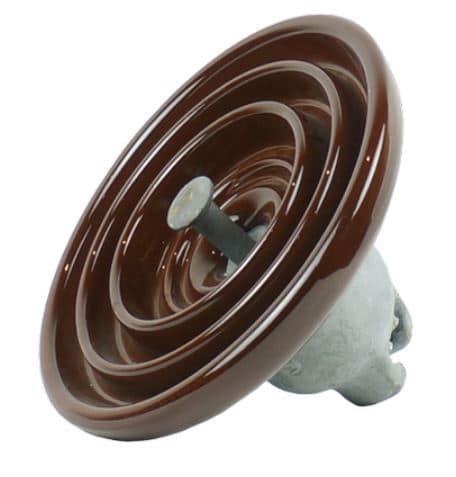
As the name suggests, the shape of the insulator is like a disc hence it is called a disc insulator. These types of insulators are used in high voltage transmission and distribution lines. Disc insulators are designed to meet the required electro-mechanical strength.
In addition, they are a cost-effective solution for medium and low polluted environments. The applications of these insulators include transmission lines, industrial and commercial as they have high efficient features like low corrosion, robust design.
They provide insulation as well as support to line conductors in suspension and tension systems. Also, it is capable of maintaining high voltages within high loads.
| Advantages of Disc Insulator | Disadvantages of Disc Insulator |
|---|---|
| It has a voltage rating of 11KV, so a suspension string can be made with a set of discs. | The insulator strings are expensive compared to other types. |
| Due to the hanging line on the elastic suspension string, the mechanical pressure is low. | They require greater higher for supporting tower and maintaining the ground permission of the conductor. |
| If the disc gets damaged it can be replaced very easily. | It usually requires a cross arm with a higher length. |
| It protects against noise, electricity, heat and also supports the overhead conductor. | The tower needs to be stronger to withstand the weight of the insulator. |
#2 Post Insulators
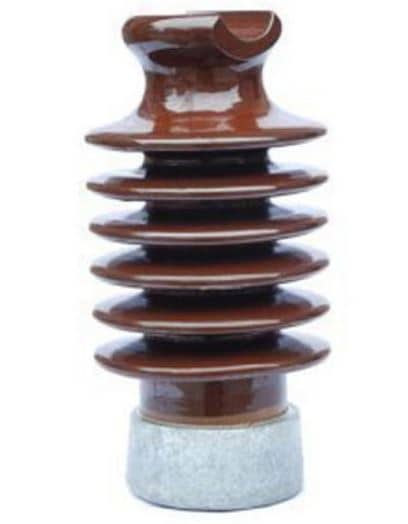
It is a high voltage insulator designed to be used in substations because it is suitable for different voltage levels. These are employed because they ensure the safe and stable distribution of electricity generated in power plants.
Post insulators are made of ceramic material or of a single piece of composite material (silicone rubber) and are capable of carrying power up to 1100KV. It is placed in a vertical position and is widely used to protect transformers, switchgear, and other connecting equipment due to its excellent mechanical properties.
| Advantages of Post Insulator | Disadvantages of Post Insulator |
|---|---|
| These have good chemical and thermal strength. | Due to the lightweight of the post insulator, it provides less load on the supporting structure. |
| Post insulators can be readily manufactured for specified mechanical loads of strengths of hundreds of kilovolts. | The initial cost will be cheap but the longevity of the insulator is really low. |
| It is light in weight and has a low risk of damage. |
#3 Pin Insulators
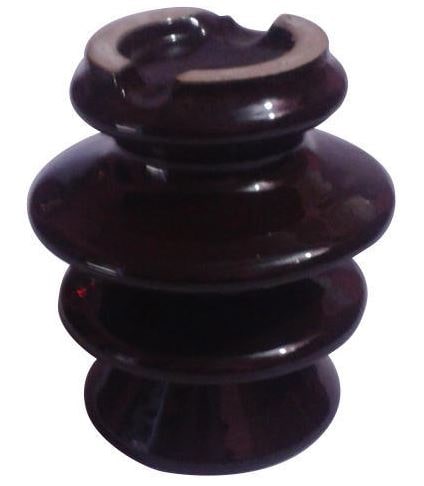
The pin insulators are mostly seen in power distribution lines. It is a device that insulates a wire from physical support such as a pin (wooden or metal dowel) on a utility pole. It is a single-layer shape made of a non-conducting material, usually porcelain or glass.
Single or number of pin insulators can be used on physical support, depending on the application of voltage. The pin insulator is capable of carrying voltages up to 11kV and is designed with a high mechanical strength material. These are arranged in either a vertical or a horizontal position.
| Advantages of Pin Insulator | Disadvantages of Pin Insulator |
|---|---|
| Pin insulator has greater mechanical strength and good creepage distance. | It requires a spindle to arrange the insulator. |
| These are well suitable for high voltage power distribution lines. | The voltage rating is limited to 36kV and is used only in the distribution line. |
| The main advantage is that it can be mounted vertically and horizontally. | The pin of the insulator can damage the insulator thread. |
#4 Strain Insulators
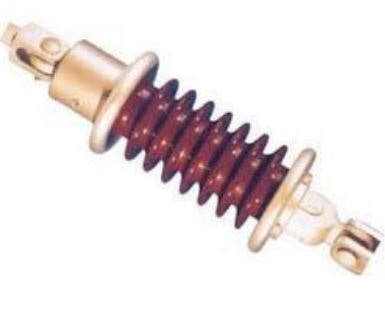
These types of insulators are designed to operate under mechanical stress to withstand the stretch of a suspended electrical wire or cable. It is similar to a suspension insulator as it is used to support radio antennas and overhead power lines.
A strain insulator is arranged between two lengths of wire to electrically separate them from each other while maintaining a mechanical connection. Or used where a wire joins a pole or tower, to deliver the pull of wire to support while electrically insulating it. These insulators have a voltage potential of about 33kV.
Advantages of Strain Insulator
- These are easily designed from a piece of glass, porcelain, or fiberglass.
- If the insulator is damaged, the stay or guy wire will not fall on the ground.
- For low-voltage line application, the strain insulator is insulated from the ground.
#5 Suspension Insulators
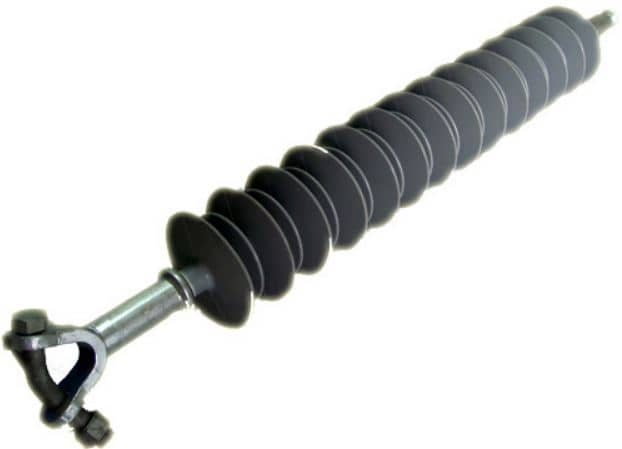
These types of insulators are generally used as conductors to protect the overhead transmission lines. The suspension insulator is commonly made of porcelain material and is used in towers. They have a number of insulators that are connected in series to a form string.
It is hinged on the cross arm of the tower and carries a power conductor at its lowest end. These are used where a higher voltage of about 33 kV is required. Pin insulator becomes economical as the size, weight of the insulator becomes more. To overcome these difficulties, a suspension insulator is used.
| The Advantages of Suspension Insulator | Disadvantages of Suspension Insulator |
|---|---|
| Each unit can operate on a voltage of around 11kV. | Insulator string is expensive as compared to pin-type and post-type insulators. |
| If the entire unit wears out, it can easily be replaced with a new unit without replacing the string. | It requires a greater height of the supporting structure to maintain the same ground clearance as the current conductor. |
| The string is free to swing in any direction so it has high flexibility. | In this, the amplitude of free swing of the conductors is more, so there is more gap between the conductors. |
| Insulator cost is considerably low. |
Read Also: What is Inductor? How They Work & Their Types [PDF]
#6 Shackle Insulators
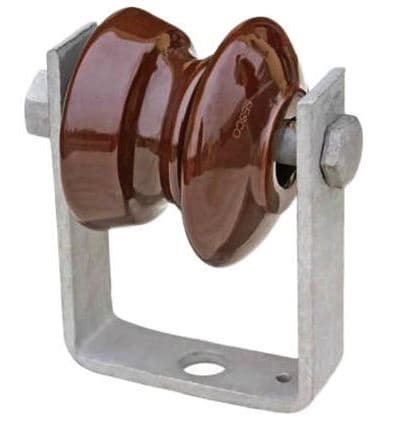
Shackle insulators are generally small in size and used in low voltage distribution systems. This type of insulator can be used in both vertical and horizontal positions. The connection of this insulator can be done using a metal strip and is capable of carrying a voltage of about 33 kV.
It has a tapered hole that distributes the load force more consistently, reducing the chance of fracture once heavily loaded. The use of insulators has decreased recently after the widespread use of underground cables for distribution purposes.
| Advantages of Shackle Insulator | Disadvantages of Shackle Insulator |
|---|---|
| Shackle insulators can be easily designed to meet power requirements. | These types of insulators are highly reliable for conductors. |
| They can be arranged vertically as well as horizontally according to the application. | They are only for low voltage distribution grids. |
| These are the most satisfactory solutions for ensuring safety in various electrical equipment. |
#7 Stay Insulators
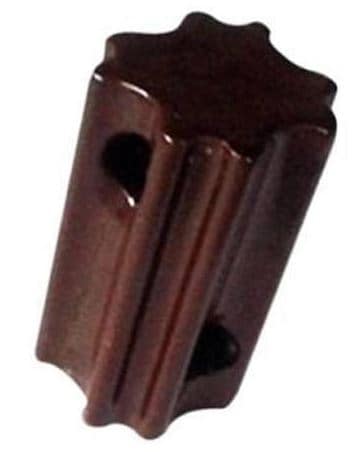
It is a type of low voltage insulator designed to counterweight and fasten dead-end poles by combining a stay wire or main grip. These insulators are rectangular in shape and are available in smaller sizes than other types.
These insulators can be arranged between the line conductor and the earth. In addition, they also act as protection devices that protect against sudden faults otherwise sudden voltage changes. The importance of these insulators is seen when the poles fall to the ground or when the stay wires are accidentally broken due to additional mechanical load.
| Advantages of Stay Insulator | Disadvantages of Stay Insulator |
|---|---|
| These are mainly useful on guy wire configurations to balance tensile. | They are only used for low voltage transmission lines |
| In addition, they play an important role in supporting the insulating between the transmission poles. |
#8 Polymer Insulators
These are a type of electrical equipment usually made of polymer materials and metal fittings. Furthermore, these insulators are made of fiberglass rods and are surrounded by polymer weather sheds. Weather shades shield the insulator core from the outer environment.
Polymer insulators are lighter in weight than the porcelain type while providing better power. In general, it is considered a good insulator for both heat and electricity. It is used as an insulator due to its unique electrical, mechanical, chemical, and thermal properties.
| Advantages of Polymer Insulator | Disadvantages of Polymer Insulator |
|---|---|
| When compared to a porcelain insulator, a polymer insulator have a higher tensile strength. | Moisture can enter the core when there is a gap between the core and the weather shed. This can damage the insulator. |
| Performance is far better than other types, especially in polluted areas. | Over-crimping in fittings can crack the core which leads to mechanical failure of the insulator. |
| Due to its lightweight, it puts less load on the supporting structure. | |
| Less maintenance is required due to the hydrophobic nature of the insulator. |
#9 Glass Insulators
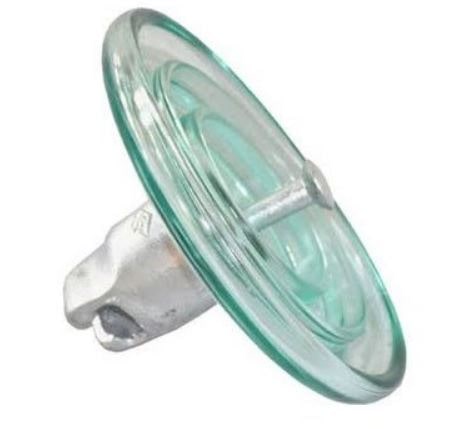
These are types of insulators used in power transmission lines that are usually made of annealed or toughened glass. The purpose of this insulator is to insulate the electrical wires, so that electricity does not leak into all the poles and into the earth.
Previously, glass insulators were used in telegraph and telephone lines, which were later replaced by ceramic and porcelain types in the 19th century. To overcome the weakness of the glass, toughened glass types were introduced, which became popular due to their long life span.
| Advantages of Glass Insulator | Disadvantages of Glass Insulator |
|---|---|
| It has much higher dielectric strength than porcelain insulators. | Moisture can easily condense on its surface, limiting its use to low voltage. |
| Due to the transparency of the glass, impurities and air bubbles can be easily detected inside the insulator. | For high voltages, the glass cannot be cast into an irregular shape, because irregular cooling causes internal cooling and stress. |
| The resistivity is very high, plus it has a low coefficient of thermal expansion. |
#10 Long Rod Insulators
The long rod insulators are usually hinged on steel towers to insolate the transmission lines. In addition, they also act as protection devices as they supply power safely. Depending on the use and requirement, long rod insulators are generally composed of multiple insulators.
These are porcelain rods with weather shed and metal end fittings on the outside. The advantage of employing this type of insulator is that they are applicable for use in both tension and suspension locations.
Advantages of Long Rod Insulator
- The long rod insulator has many advantages like non-breakdown, good self-cleaning, low breakage, etc.
- They can provide better insulation performance under pollution conditions.
- Fairly low weight for a complete insulator set and simple mounting of strings.
Wrap Up
As I already said, the insulator is a device that does not conduct electricity easily. Thus, a brief idea is obtained about the types of insulators used in transmission lines and each type has its own application.
Some of the criteria to be considered while choosing an insulator are a dielectric factor, operating temperature, economic factor, and recognized material.
So for now, I hope I’ve covered everything about “types of insulators“. If you still have any doubts or questions regarding this topic, you can contact us or ask in the comments, we will reply to you. If you liked it, then share this with your friends and spread the knowledge.
Want free PDFs sitting at home? Then subscribe to our newsletter.
Download PDF of this article:
You might like to read more about electrical engineering:
There are ver few articles about insulators. But i came at the right place. All the infromation avaiable here.
Thanks for your feedback.
thank you for the information
You’re welcome.
Sent me this one kindly sir
The PDF file has been sent to your inbox.
Thanks so much. But I would like so many pdf of electrical
You’re welcome. Here you can get the PDFs for free so keep visiting.